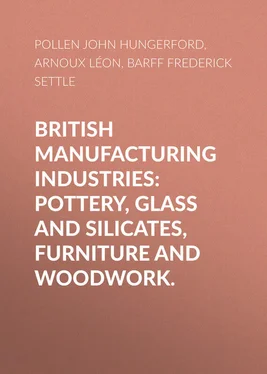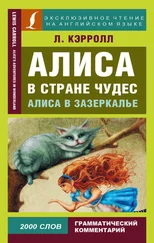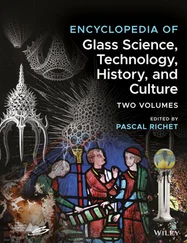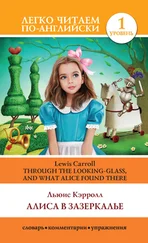John Pollen - British Manufacturing Industries - Pottery, Glass and Silicates, Furniture and Woodwork.
Здесь есть возможность читать онлайн «John Pollen - British Manufacturing Industries - Pottery, Glass and Silicates, Furniture and Woodwork.» — ознакомительный отрывок электронной книги совершенно бесплатно, а после прочтения отрывка купить полную версию. В некоторых случаях можно слушать аудио, скачать через торрент в формате fb2 и присутствует краткое содержание. ISBN: , Жанр: foreign_antique, foreign_prose, на английском языке. Описание произведения, (предисловие) а так же отзывы посетителей доступны на портале библиотеки ЛибКат.
- Название:British Manufacturing Industries: Pottery, Glass and Silicates, Furniture and Woodwork.
- Автор:
- Жанр:
- Год:неизвестен
- ISBN:http://www.gutenberg.org/ebooks/38953
- Рейтинг книги:5 / 5. Голосов: 1
-
Избранное:Добавить в избранное
- Отзывы:
-
Ваша оценка:
- 100
- 1
- 2
- 3
- 4
- 5
British Manufacturing Industries: Pottery, Glass and Silicates, Furniture and Woodwork.: краткое содержание, описание и аннотация
Предлагаем к чтению аннотацию, описание, краткое содержание или предисловие (зависит от того, что написал сам автор книги «British Manufacturing Industries: Pottery, Glass and Silicates, Furniture and Woodwork.»). Если вы не нашли необходимую информацию о книге — напишите в комментариях, мы постараемся отыскать её.
British Manufacturing Industries: Pottery, Glass and Silicates, Furniture and Woodwork. — читать онлайн ознакомительный отрывок
Ниже представлен текст книги, разбитый по страницам. Система сохранения места последней прочитанной страницы, позволяет с удобством читать онлайн бесплатно книгу «British Manufacturing Industries: Pottery, Glass and Silicates, Furniture and Woodwork.», без необходимости каждый раз заново искать на чём Вы остановились. Поставьте закладку, и сможете в любой момент перейти на страницу, на которой закончили чтение.
Интервал:
Закладка:
Modern chemistry has placed at the disposal of colour makers new compounds which have made the preparation of fluxes comparatively easy. At the present time two classes are required: those in which the oxides of lead predominate, and those chiefly made with borax, which on account of its great purity is used in almost every flux, and is of great service for those colours which, like the pinks and purples, would suffer from the presence of lead.
The preparation of painting colours is a little more complicated, and each requires a different treatment. The number of those found in the trade is rather large, and each artist has his favourite maker. In this, as in any other kind of painting, beginners are apt to think that they will be assisted by the use of a great variety of tints, when they will learn by more experience, that a very limited number is sufficient. I cannot undertake to give any receipts for those who might wish to prepare these themselves; I only mention the name of the substances necessary to secure each of the essential colours.
White is not a colour, but when wanted on a coloured body, it is procured by an enamel prepared with the oxide of tin. Light yellow requires the oxides of lead and antimony. Orange will require the same, with an addition of deutoxide of iron. The hydrate of peroxide of the same metal will give a golden buff. The subchromate of lead gives a very bright red, but it is very unsafe and mixes badly; the reds made by calcining the common sulphate of iron are preferred. From this, according to the degree of fire, all shades of red may be got, from an orange red to a deep purple brown. The pinks, purples, and crimsons are made from the precipitate of cassius; this is obtained by pouring a weak solution of tin in the chloride of gold. The dark blue is a triple silicate of cobalt, which, by the admixture of the white oxide of zinc, may be converted into a brighter blue. The green oxide of chrome is the base of all greens, the tint of which is modified by cobalt for the blue greens, and antimony for the yellow greens. The chromate of iron, a mineral coming in large quantities from South America, is the base of all browns. The black may be got from the mixture of various oxides, but the best is that made from the oxide of iridium. Besides the above, there is another class of colours in which the oxides are thoroughly combined with the fluxes, such as the greens made from copper and the transparent blues, which are ground colours, and must be classified with the glazes. When painting colours are fired with their respective fluxes, they are very permanent, and will not only resist ordinary atmospheric influences, but also the action of every gas or mineral acid (the fluoric excepted). This seems an advantage in favour of painting on pottery, and one which ought to give them an additional value; in reality, however, artistic merit ranks above all other considerations, and unless the work is original, connoisseurs in pottery will hardly take this into account.
Several oils possessing drying properties, such as those of lavender, aniseed, or turpentine, are mixed with the colours, which, from the fact of containing vitreous substances, would work badly; even with their assistance, it requires a certain amount of skill to master the process. We must not make too much, however, of this difficulty, generally exaggerated by the ignorance of apprentices in what constitutes the very principles of their profession. When parents, in perfect ignorance of the abilities of their son, have decided, after putting their heads together, that he shall be a painter, sometimes for no other consideration than that they can get him admission into a porcelain manufactory, or that this is the nearest to their home, the boy has not the least notion of what is before him, and hardly knows that he will have to learn that very difficult thing, drawing. No wonder then, if his deficiency in this will not allow him to produce, we will not say good, but saleable paintings, unless he has spent a dozen years on his trial. On the contrary, to one well prepared by the study of art – one who, before he sets to his work, has a clear conception of the effect which he wishes to produce – the process will not stand in the way, and he will master it in the course of a few weeks.
To induce talented men to devote their time to the decoration of pottery, is perhaps the greatest difficulty met with by our leading manufacturers. As long as the making of the ware only was concerned, they had to call for the assistance of practical men, such as potters, chemists, or engineers, the number of whom is fortunately great in England, and whose services can be secured by money. The same thing is not so easy in the matter of art. Up to a recent date, painting on pottery was not considered as the high road to fortune, and artists preferred to try their chance in oil or water-colour painting, fully aware that they would have to fight against an army of competitors, and to be satisfied with very small incomes, unless, by their, then problematic, genius, they could cut their way to the front. Since, however, the rage (there is no other word for it) for well decorated pottery has spread in almost every class of society, the prices paid for good work are more remunerative, and artists like Solon, Mussill, and Coleman, can make artistic pottery their special business.
Royal Academicians like Poynter and Marks have thought it not beneath them to prepare cartoons for Minton, and it is probable that others would follow in the same path if, with the assistance of our chief potters, they could be initiated into some of the mysteries of the craft. No doubt they would find the study attractive, and there is no fear that, having once begun, they would not keep faithfully to it. For myself, I know of no such example.
In addition to the painting colours, there are a few metals which are used to enrich pottery; unfortunately, the number of those which can undergo exposure to a red heat without oxidizing is very limited. There are only three, viz. gold, silver, and platinum, which can stand it, and, among these, silver is of little use, on account of its proneness to tarnish under the action of sulphurous gases. Gold, on the contrary, affords to the decorator one of his greatest resources. We cannot say when the Chinese began to use it; we only know that in Europe it was thought a great discovery, when, in the sixteenth century, it was used in the Italian majolica. From that time to the introduction of hard and soft porcelain in Europe, it was rarely and sparingly used; and it was at Meyssen, soon followed by the other continental and English manufactories, that they began to use it extensively. At the present time, its annual consumption by our Staffordshire potters alone represents a very large sum of money. There are several ways of preparing gold for pottery purposes; the oldest consists in grinding gold leaves on a slab, adding to it gum water, honey, or any other mucilaginous liquid. This laborious process surpasses all others; it has a very artistic effect when used thin, in the Chinese fashion, and, when laid thick, as we find it in the Old Sèvres ware, it answers beautifully for chasing; the only drawback is the expense. The most usual way is to have it amalgamated with mercury, and afterwards ground in turpentine; it has then the appearance of a blackish substance, which will regain its colour, as soon as the mercury is volatilized by the application of a gentle heat. When it comes out of the kiln, the gold is dull, and requires to be burnished with agate and bloodstone tools, to be in possession of all its brightness.
There is another decorated pottery, called lustre ware, now out of fashion, but most successfully executed at one time by the Moors, the Persians, and the Italians on their respective majolicas; the glaze of this ware being more favourable than any other for the display of the process. It simply consisted in painting over the fired ware with the protoxide of some metal, such as that of copper, taking care that from the moment the kiln began to get to the red heat, a constant supply of thick smoke should be kept up. The partial reduction of the metal which adheres to the surface has a very pleasing effect, as may be noticed in the large Hispano-Moresco dishes, considered the finest specimens of this class. Those produced in Italy by Georgio Andreoli fetch, however, a higher price, on account of the redness of their colour; the process is fully described in the celebrated manuscript of Piccolo Passo, now in the library of the South Kensington Museum. Lessore, the French painter, lately dead, and M. de Morgan, in London, have succeeded in producing very fair specimens of that kind. Some of our Staffordshire potters can make another lustre by mixing chloride of gold with lavender oil, sulphur, resin, and other carburated ingredients, and laying this mixture very thinly on the surface of the glazed ware; the iridescent pinkish colour which it takes when it is fired in an ordinary kiln is rather peculiar. This has no connection with the old process, and is only used for the commonest kind of goods.
Читать дальшеИнтервал:
Закладка:
Похожие книги на «British Manufacturing Industries: Pottery, Glass and Silicates, Furniture and Woodwork.»
Представляем Вашему вниманию похожие книги на «British Manufacturing Industries: Pottery, Glass and Silicates, Furniture and Woodwork.» списком для выбора. Мы отобрали схожую по названию и смыслу литературу в надежде предоставить читателям больше вариантов отыскать новые, интересные, ещё непрочитанные произведения.
Обсуждение, отзывы о книге «British Manufacturing Industries: Pottery, Glass and Silicates, Furniture and Woodwork.» и просто собственные мнения читателей. Оставьте ваши комментарии, напишите, что Вы думаете о произведении, его смысле или главных героях. Укажите что конкретно понравилось, а что нет, и почему Вы так считаете.












![John Bruce - The Lettsomian Lectures on Diseases and Disorders of the Heart and Arteries in Middle and Advanced Life [1900-1901]](/books/749387/john-bruce-the-lettsomian-lectures-on-diseases-and-disorders-of-the-heart-and-arteries-in-middle-and-advanced-life-1900-1901-thumb.webp)